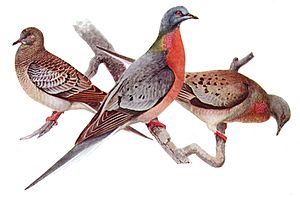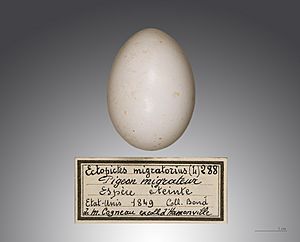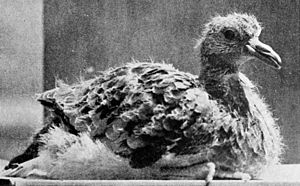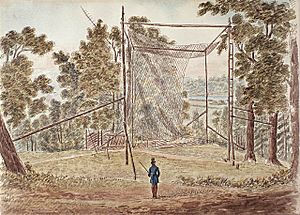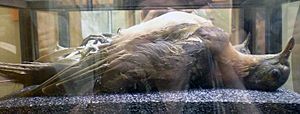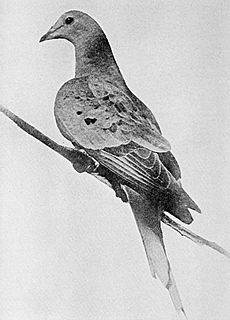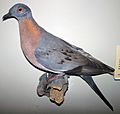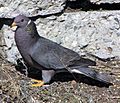Passenger pigeon facts for kids
Quick facts for kids Passenger pigeon |
|
|---|---|
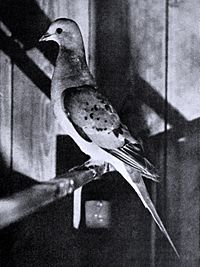 |
|
| 1898 photograph of a live passenger pigeon | |
| Conservation status | |
| Scientific classification | |
| Kingdom: | |
| Class: | |
| Order: | |
| Family: | |
| Genus: |
Ectopistes
Swainson, 1827
|
| Binomial name | |
| Ectopistes migratorius (Linnaeus, 1766)
|
|
The passenger pigeon (Ectopistes migratorius) or wild pigeon was a species of pigeon that was once the most common bird in North America.
Contents
Description
The passenger pigeon, or, wild pigeon was a species of bird, Ectopistes migratorius, that was once common in North America. It lived in enormous migratory flocks — sometimes containing more than two billion birds — that could stretch one mile (1.6 km) wide and 300 miles (500 km) long across the sky, sometimes taking several hours to pass.
Some estimate that there were three billion to five billion passenger pigeons in the United States when Europeans arrived in North America. Others argue that the species had not been common in the Pre-Columbian period, but their numbers grew when devastation of the American Indian population by European diseases led to reduced competition for food.
The species went from being one of the most usual birds in the world during the 19th century to extinction early in the 20th century. At the time, passenger pigeons had one of the largest groups or flocks of any animal, second only to the Rocky Mountain locust.
Some reduction in numbers happened because of habitat loss when the Europeans started settling further inland. The primary factor emerged when pigeon meat was commercialized as a cheap food for slaves and the poor in the 19th century, resulting in hunting on a massive scale. There was a slow decline in their numbers between about 1800 and 1870, followed by a catastrophic decline between 1870 and 1890. Martha, thought to be the world's last passenger pigeon, died on September 1, 1914, in Cincinnati, Ohio.
In the 18th century, the passenger pigeon in Europe was known to the French as tourtre; but, in New France, the North American bird was called tourte. In modern French, the bird is known as the pigeon migrateur.
In Algonquian languages, it was called amimi by the Lenape and omiimii by the Ojibwe. The term passenger pigeon in English derives from the French word passager, meaning to pass by.
Description
The Passenger Pigeon was larger than a Mourning Dove and had a body size similar to a large Rock Pigeon. The average weight of these pigeons was 340–400 grams (12–14 oz) and, per John James Audubon's account, length was 42 cm (16.5 in) in males and 38 cm (15 in) in females. The Passenger Pigeon had a bluish gray head and rump, slate gray back, and a wine red breast. The male had black streaks on the scapulars and wing coverts and patches of pinkish iridescence at the sides of the neck changed in color to a shining metallic bronze, green, and purple at the back of the neck in various lights. Female and immature birds were similarly marked but with duller gray on the back, a lighter rose breast and much less iridescent necks. The wings were long and broad. The tail was extremely long at 20–23 cm (8–9 in) and gray to blackish with a white edge.
Behavior and ecology

The Passenger Pigeon was a very social bird. It lived in colonies stretching over hundreds of square miles, practicing communal breeding with up to a hundred nests in a single tree. It may have been the most numerous bird on earth in its heyday, and A. W. Schorger believed it accounted for between 25 and 40 percent of the total landbird population in the US.
It is hypothesized that their survival was based on the benefits of very large numbers. There was safety in large flocks which often numbered hundreds of thousands of birds. When a flock of this huge a size established itself in an area, the number of local animal predators (such as wolves, foxes, weasels, and hawks) was so small compared to the total number of birds that little damage would be inflicted on the flock as a whole. It was common for passenger pigeon flocks to perch on each other's backs, an unusual behavior even for socially inclined birds.
It is believed the bird played a large ecological role in the presettlement forests of North America through tree breakage and depositing of excrements, thereby influencing the distribution of certain tree-types.
Diet
The mainstays of the passenger pigeon's diet were beechnuts, acorns, chestnuts, seeds, and berries found in the forests. Worms and insects supplemented the diet in spring and summer. The pigeon was able to disgorge food from its crop when more desirable food became available.
Reproduction
The communal nesting sites were established in forest areas that had a sufficient supply of food and water available within daily flying range. A single site might cover many thousands of acres, and the birds were so congested in these areas that hundreds of nests could be counted in a single tree. Since no accurate data were recorded, it is only possible to give estimates on the size and population of these nesting areas. One large nesting area in Wisconsin was reported as covering 850 square miles (2,200 km2), and the number of birds nesting there was estimated to be around 136,000,000. Breeding took place from March to September, mainly between April and May.
Unlike the behaviour described by Audubon, captive specimens did not perform the bowing, strutting and billing of other pigeons. The nests were loosely constructed of small sticks and twigs and were about a foot in diameter. A single, white, elongated egg was laid per nesting. The incubation period was from twelve to fourteen days. Both parents shared the duties of incubating the egg and feeding the young. The young bird was naked and blind when born, but grew and developed rapidly. When feathered it was similar in color to that of the adult female, but its feathers were tipped with white, giving it a scaled appearance. It remained in the nest about fourteen days, being fed and cared for by the parent birds. By this time it had grown large and plump and usually weighed more than either of its parents. It had developed enough to take care of itself and soon fluttered to the ground to hunt for its food.
Habitat and distribution
The time of the spring migration depended on weather conditions. Small flocks sometimes arrived in the northern nesting areas as early as February, but the main migration occurred in March and April. The flocks would travel massive distances, and might not return to a particular location "for decades." Traveling for hours at 60 miles per hour meant that vast ranges could be covered. During summer, Passenger Pigeons lived in forest habitats throughout North America east of the Rocky Mountains from eastern and central Canada to the Northeastern United States. In the winters, they migrated to the Southern United States and occasionally to Mexico and Cuba.
Causes of extinction
The extinction of the Passenger Pigeon has two major causes. The primary cause is held to be the commercial exploitation of pigeon meat on a massive scale. Loss of habitat also played a role.
The large flocks and communal breeding of the bird became very dangerous when humans began to hunt the pigeons. When the Passenger Pigeons were massed together, especially at a huge nesting site, it was easy for people to slaughter them in such great numbers that there were not enough birds left to successfully propagate the species. As the flocks dwindled in size with resulting breakdown of social facilitation, it was doomed to disappear.
Naturalist Paul R. Ehrlich wrote that the Passenger Pigeon's extinction "illustrates a very important principle of conservation biology: it is not always necessary to kill the last pair of a species to force it to extinction. Sad to say, the lesson of the Passenger Pigeon has not been learned. At the present time the White-crowned Pigeon is threatened by the horrendous slaughter of nesting birds on its Caribbean breeding grounds."
Hunting
Prior to colonization, Aboriginal Americans occasionally used pigeons for meat. In the early 19th century, commercial hunters began netting and shooting the birds to sell in the city markets as food, as live targets for trap shooting and even as agricultural fertilizer.
Once pigeon meat became popular, commercial hunting started on a prodigious scale.
Pigeons were shipped by the boxcar-load to the eastern cities. In New York City, in 1805, a pair of pigeons sold for two cents. Slaves and servants in 18th and 19th century America often saw no other meat. By the 1850s, it was noticed that the numbers of birds seemed to be decreasing, but still the slaughter continued, accelerating to an even greater level as more railroads and telegraphs were developed after the American Civil War.
At Petoskey, Michigan in 1878, 50,000 birds were killed each day for nearly five months. The adult birds that survived the slaughter attempted second nestings at new sites, but were killed by professional hunters before they had a chance to raise any young. A state historical marker commemorates the events, including the last great nesting in 1878. Neltje Blanchan, in her book Birds That Hunt and Are Hunted documented that over a million birds were exterminated at one time from a single flock. One hunter was reputed to have personally killed "a million birds" and earned $60,000, the equivalent of $1,000,000 today. Paul Ehrlich says a "single hunter" sent three million birds to eastern cities.
Alcohol-soaked grain intoxicated the birds and made them easier to kill. Smoky fires were set to nesting trees to drive them from their nests.
Loss of habitat
Another significant reason for its extinction was deforestation. The birds traveled and reproduced in prodigious numbers, satiating predators before any substantial negative impact was made in the bird's population. As their numbers decreased along with their habitat, the birds could no longer rely on high population density for protection. Without this mechanism, many ecologists believe, the species could not survive.
Attempts at preservation
In 1857, a bill was brought forth to the Ohio State Legislature seeking protection for the Passenger Pigeon. A Select Committee of the Senate filed a report stating "The passenger pigeon needs no protection. Wonderfully prolific, having the vast forests of the North as its breeding grounds, traveling hundreds of miles in search of food, it is here today and elsewhere tomorrow, and no ordinary destruction can lessen them, or be missed from the myriads that are yearly produced."
Conservationists were ineffective in stopping the slaughter.
By the turn of the 20th century, the last group of passenger pigeons, all descended from the same pair, was kept by Professor Charles O. Whitman at the University of Chicago. The last attempt to breed the remaining specimens was done by Whitman and the Cincinnati Zoo, which included attempts at making a rock dove foster passenger pigeon eggs. Whitman sent Martha, which was to be the last known specimen, to Cincinnati Zoo in 1902.
Last wild survivors
The last fully authenticated record of a wild bird was near Sargents, Pike County, Ohio, on March 22, 1900, when the bird was killed by a boy with a BB gun. Although many unconfirmed sightings were reported in the first decade of the 20th century. From 1909 to 1912, rewards were offered for a living specimen – no specimens were found. However, unconfirmed sightings continued up to about 1930.
Reports of Passenger Pigeon sightings kept coming in from Arkansas and Louisiana, in groups of tens and twenties, until the first decade of the 20th century.
The naturalist Charles Dury, of Cincinnati, Ohio, wrote in September 1910: "One foggy day in October 1884, at 5 a.m. I looked out of my bedroom window, and as I looked six wild pigeons flew down and perched on the dead branches of a tall poplar tree that stood about one hundred feet away. As I gazed at them in delight, feeling as though old friends had come back, they quickly darted away and disappeared in the fog, the last I ever saw of any of these birds in this vicinity."
Martha
On September 1, 1914, Martha, the last known Passenger Pigeon, died in the Cincinnati Zoo, Cincinnati, Ohio. Her body was frozen into a block of ice and sent to the Smithsonian Institution, where it was skinned, dissected, photographed and mounted. Currently, Martha (named after Martha Washington) is in the museum's archived collection, and not on display. A memorial statue of Martha stands on the grounds of the Cincinnati Zoo.
John Herald, a bluegrass singer wrote a song dedicated to Martha, entitled "Martha: Last of the passenger pigeons". The song tells the story about the Passenger Pigeon's extinction and Martha's life in her cage in Cincinnati Zoo.
Images for kids
-
Earliest published illustration of the species (a male), Mark Catesby, 1731
-
Mounted male passenger pigeon, Field Museum of Natural History
-
Band-tailed pigeon, a species in the related genus Patagioenas
-
The physically similar mourning dove is not closely related.
-
Musical notes documenting male vocalizations, compiled by Wallace Craig, 1911
-
Acorns in South Carolina, among the diet of this bird
-
Internal organs of Martha, the last individual: cr. denotes the crop, gz. the gizzard, 1915
-
Male and female by Louis Agassiz Fuertes, frontispiece of William Butts Mershon's 1907 The Passenger Pigeon
-
Life drawing by Charles R. Knight, 1903
-
"The Folly of 1857 and the Lesson of 1912", frontispiece to William T. Hornaday's Our vanishing wild life (1913), showing Martha in life, the endling of the species.
-
Martha at the Smithsonian Museum, 2015
-
Taxidermized male and female, Laval University Library
See also
 In Spanish: Ectopistes migratorius para niños
In Spanish: Ectopistes migratorius para niños



